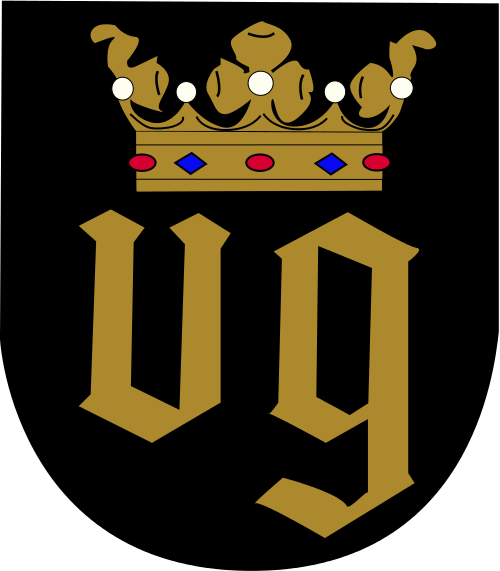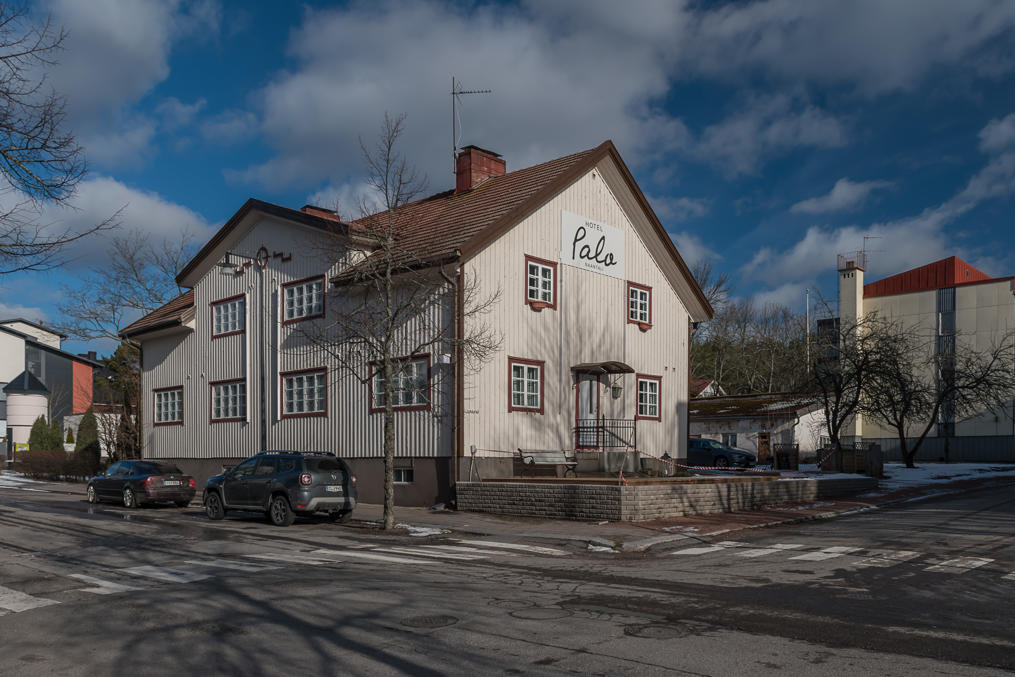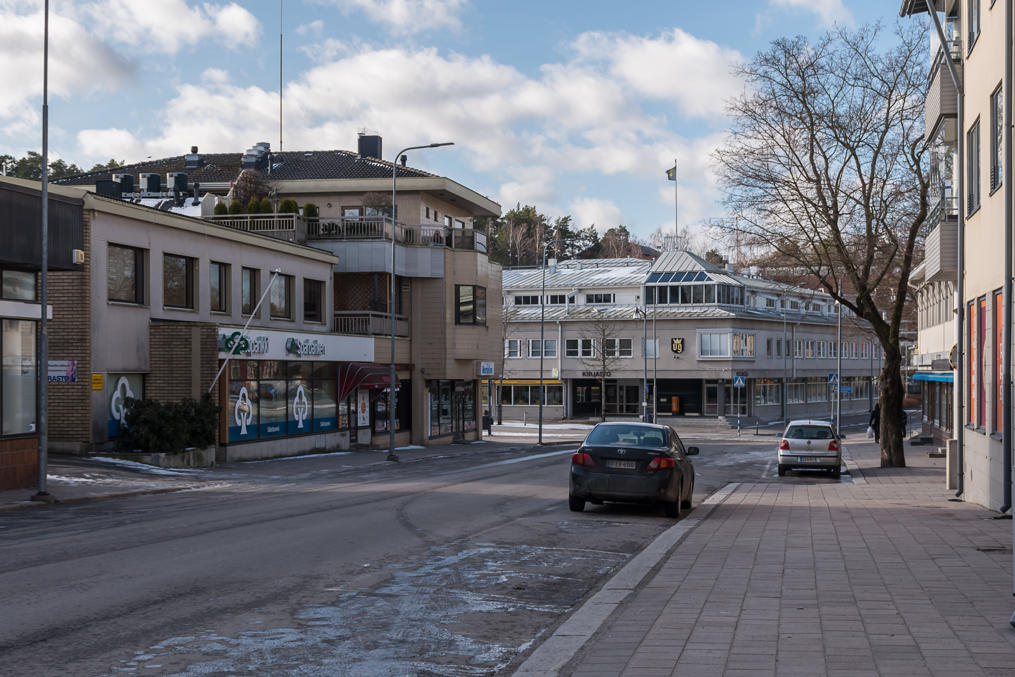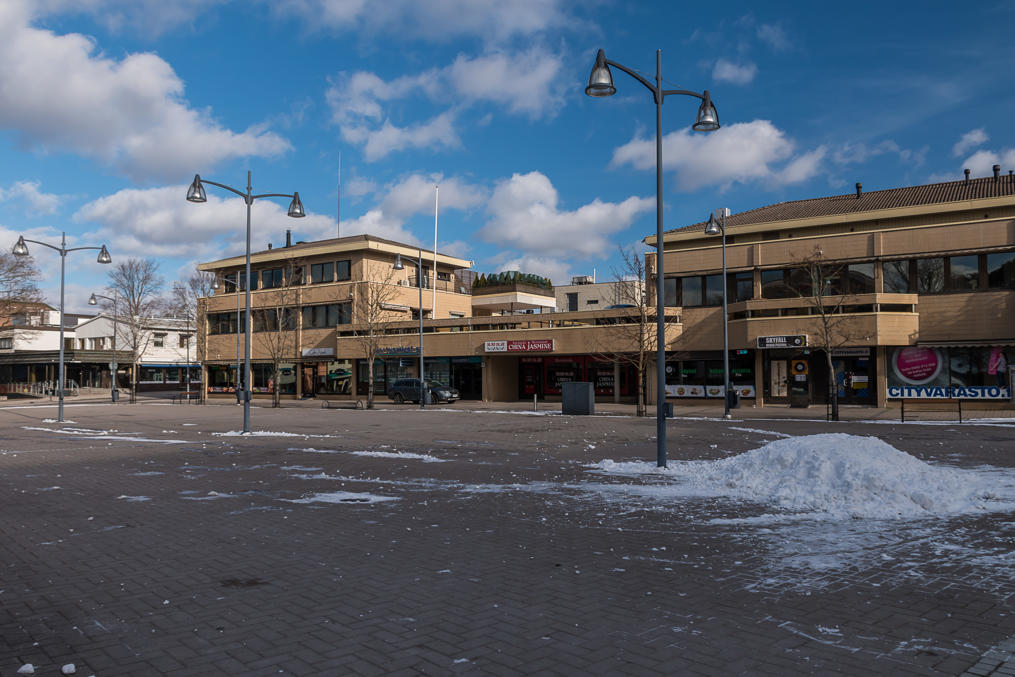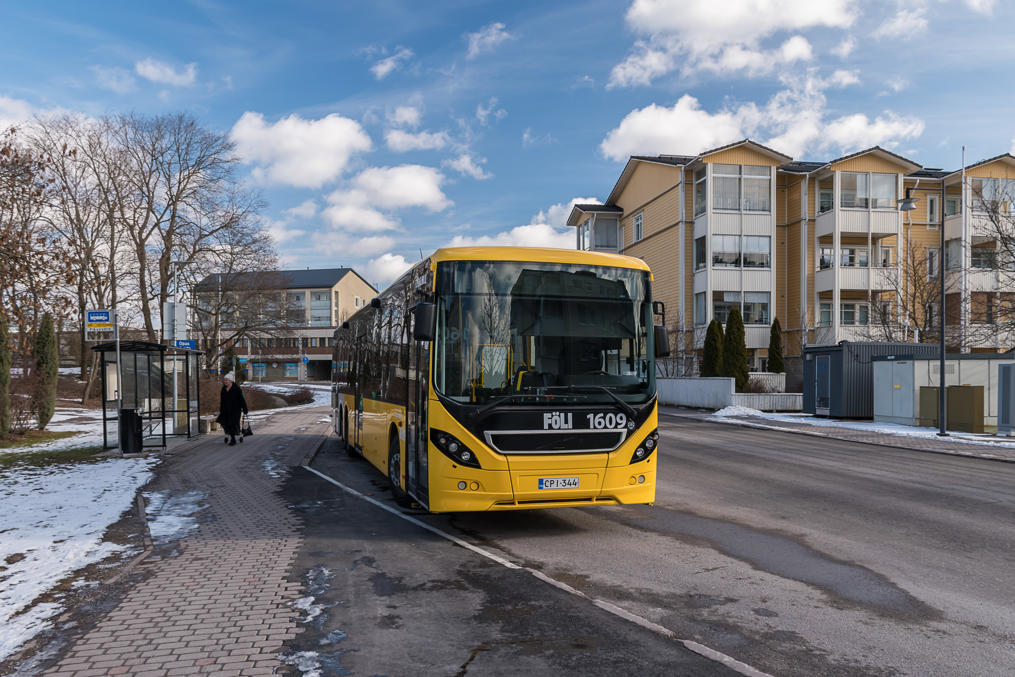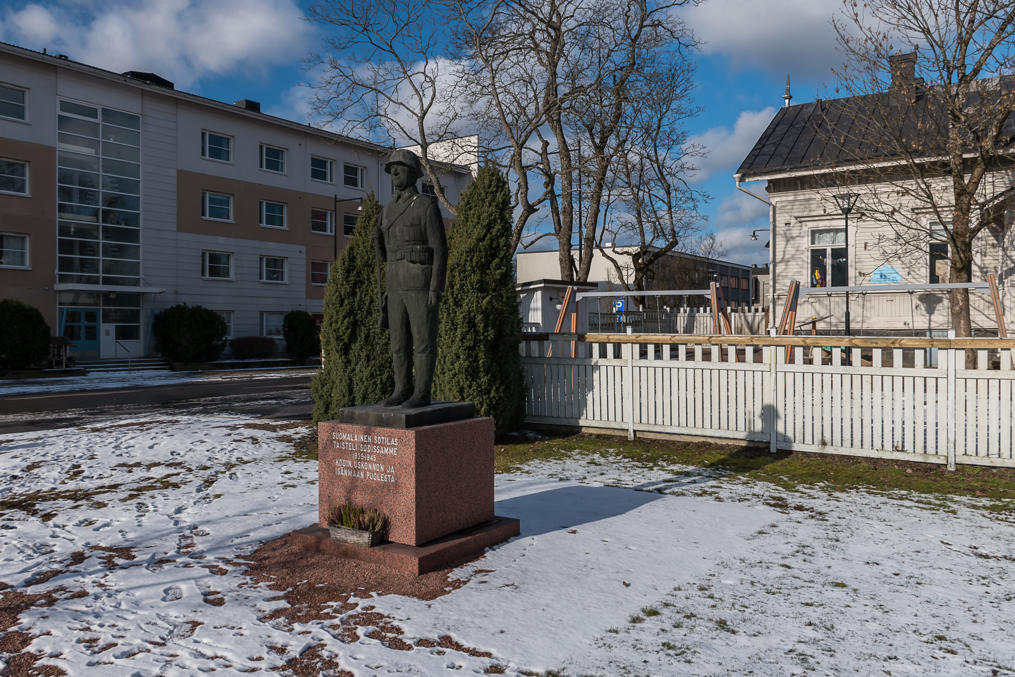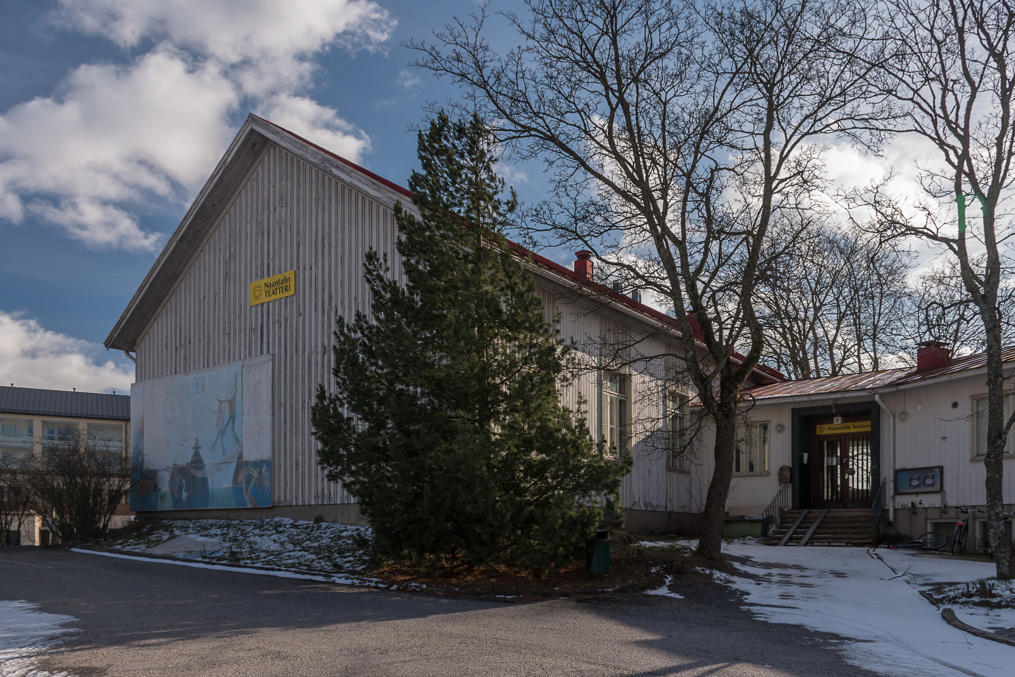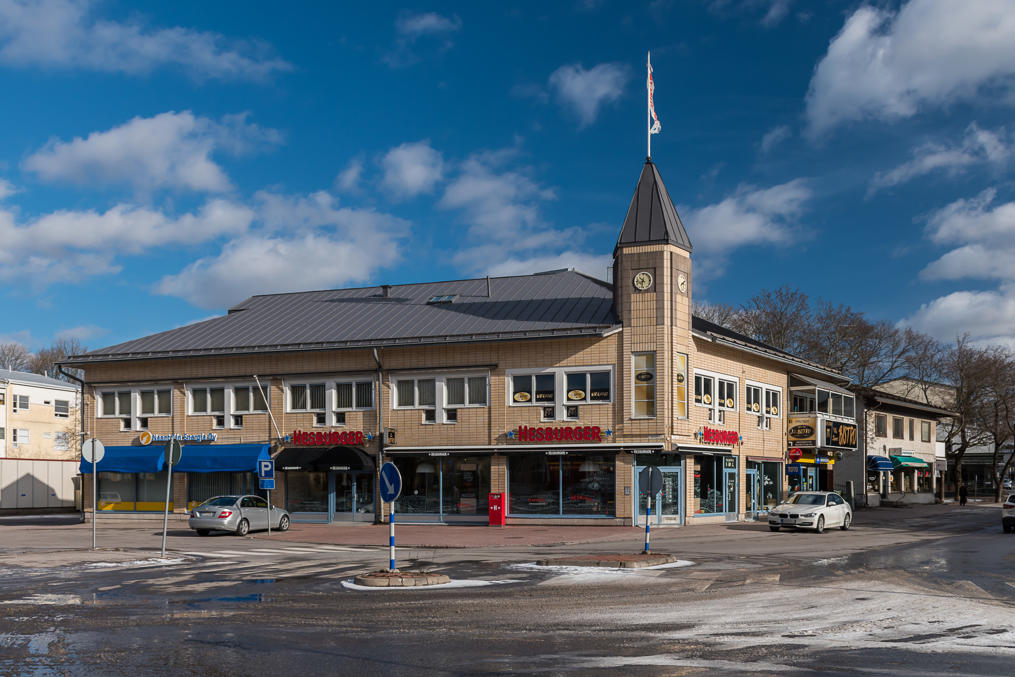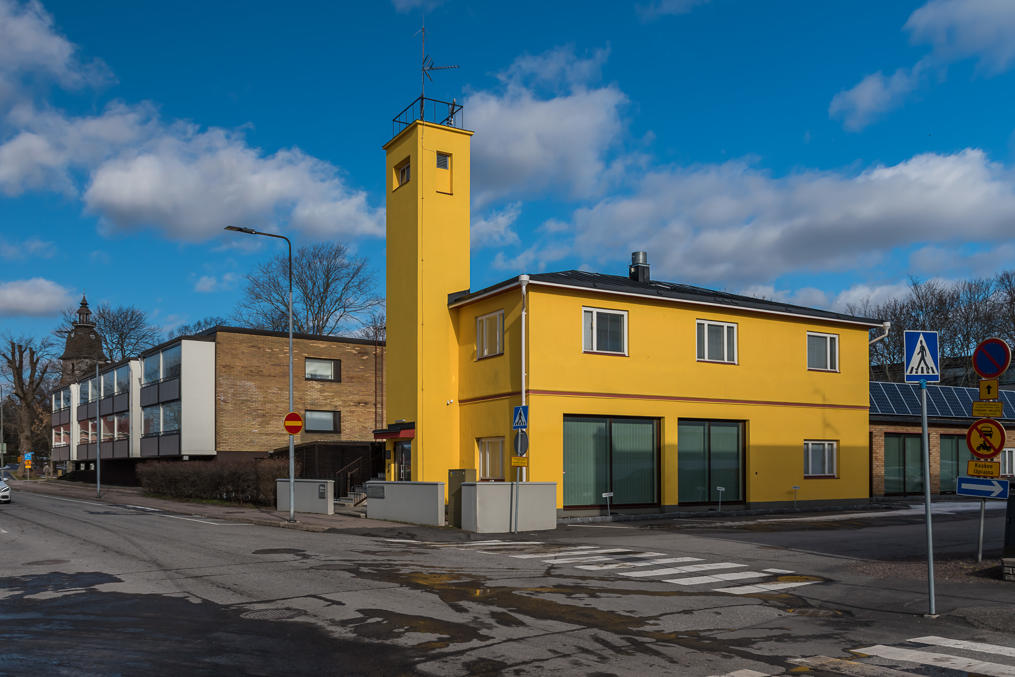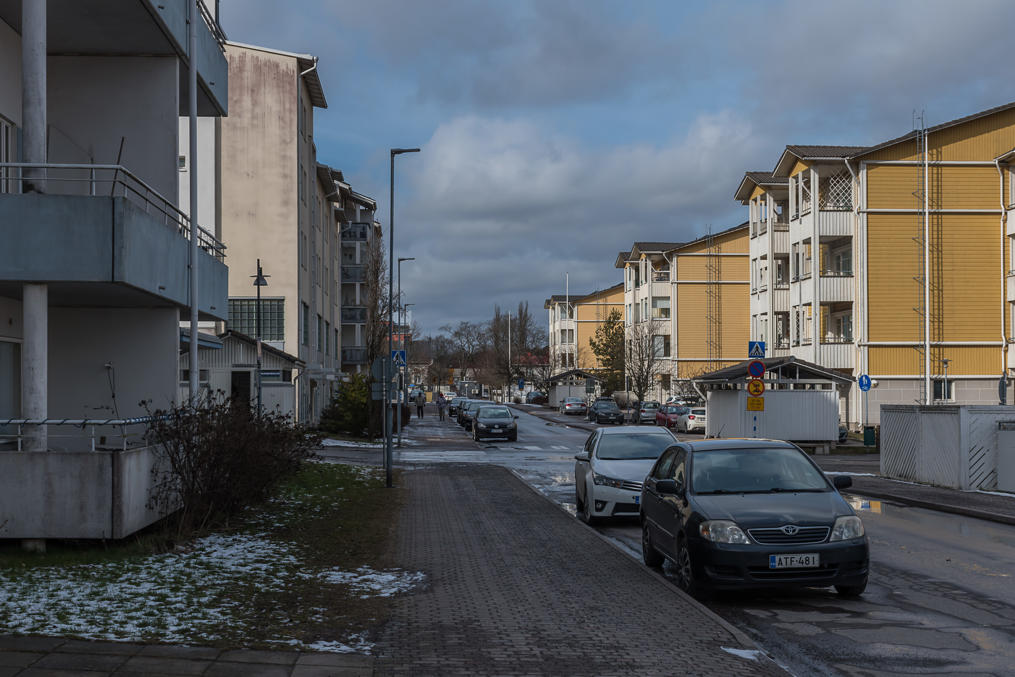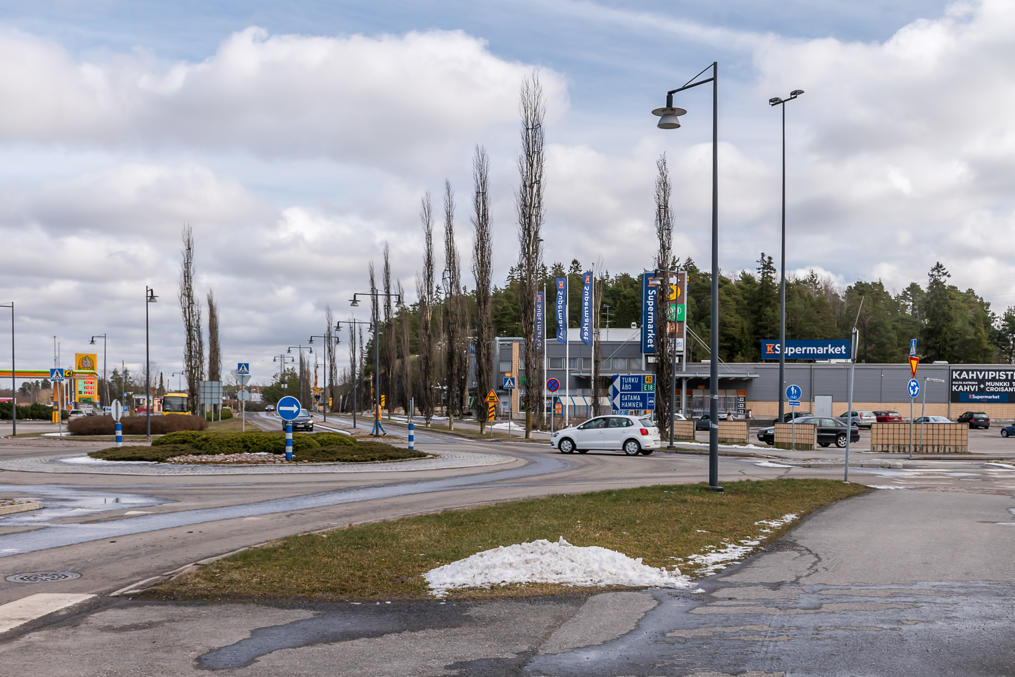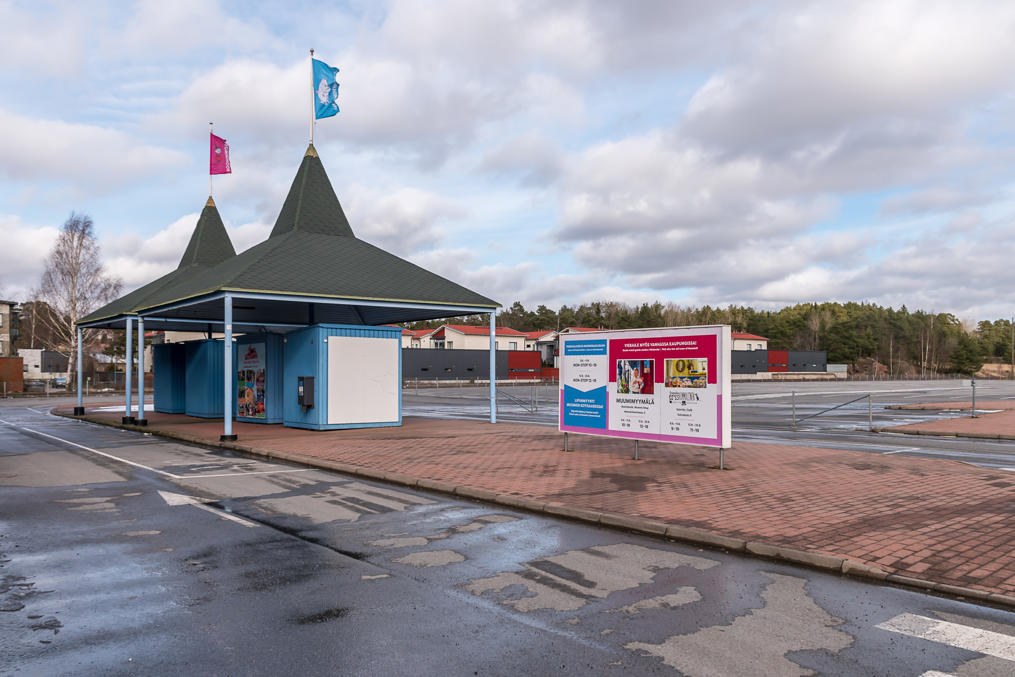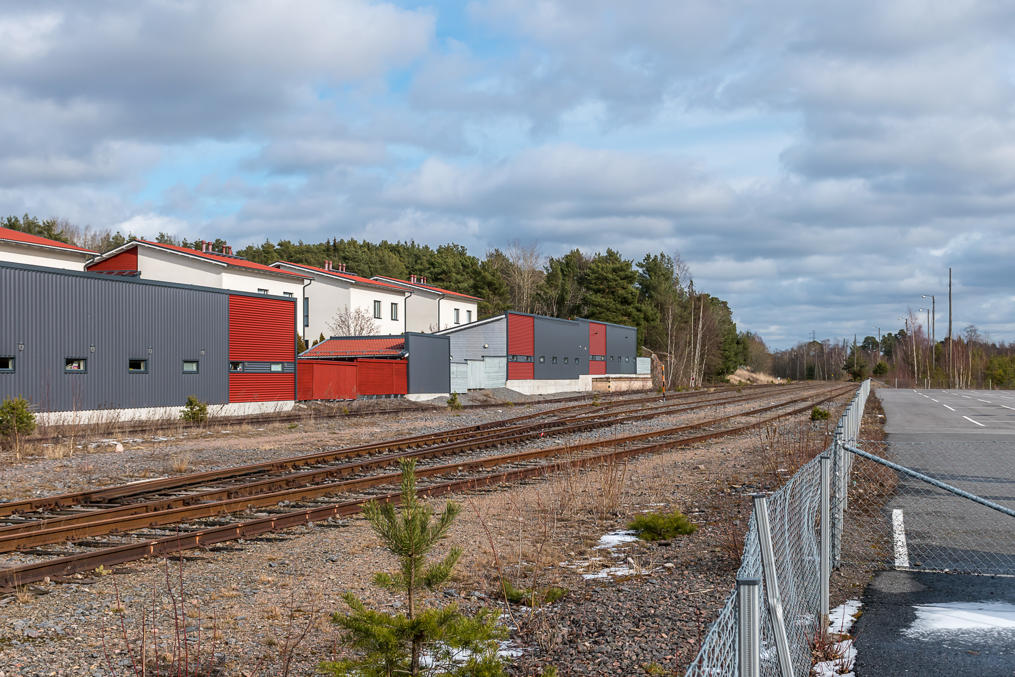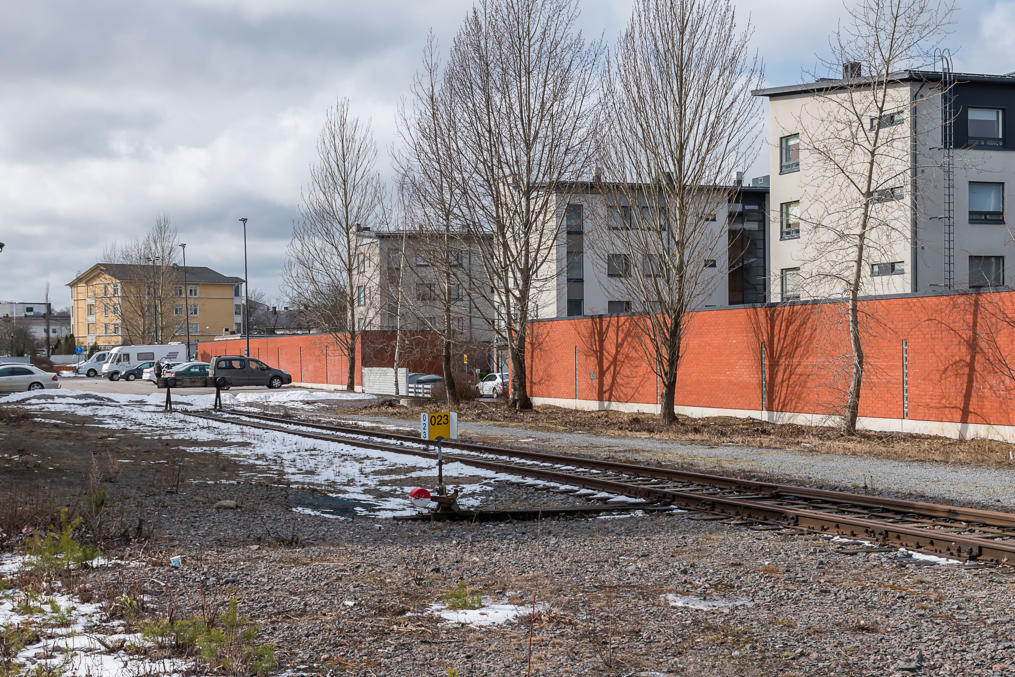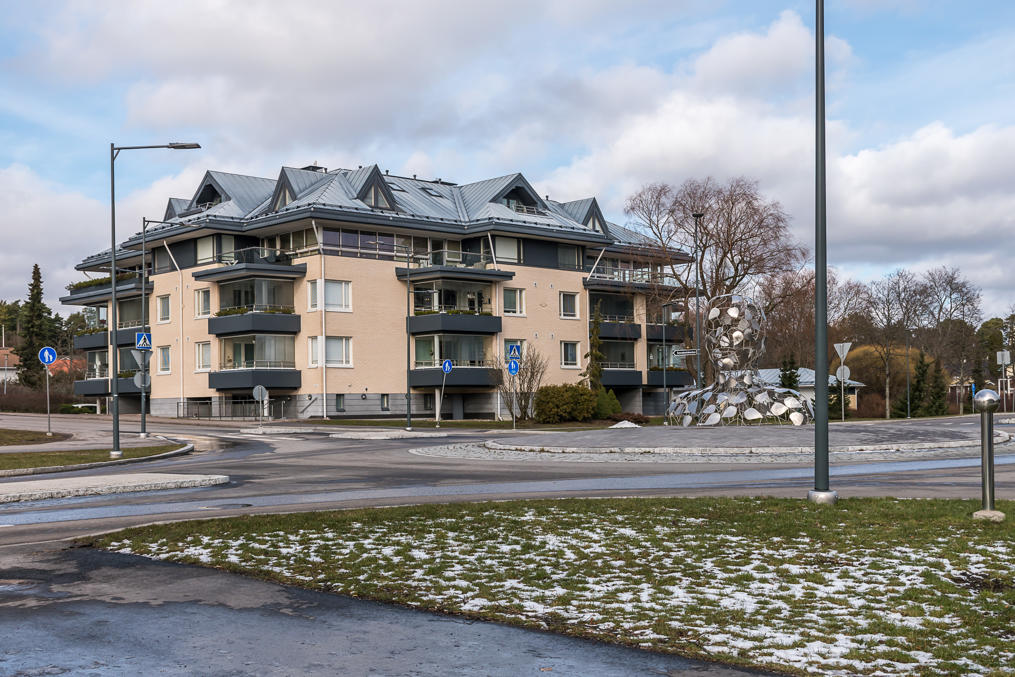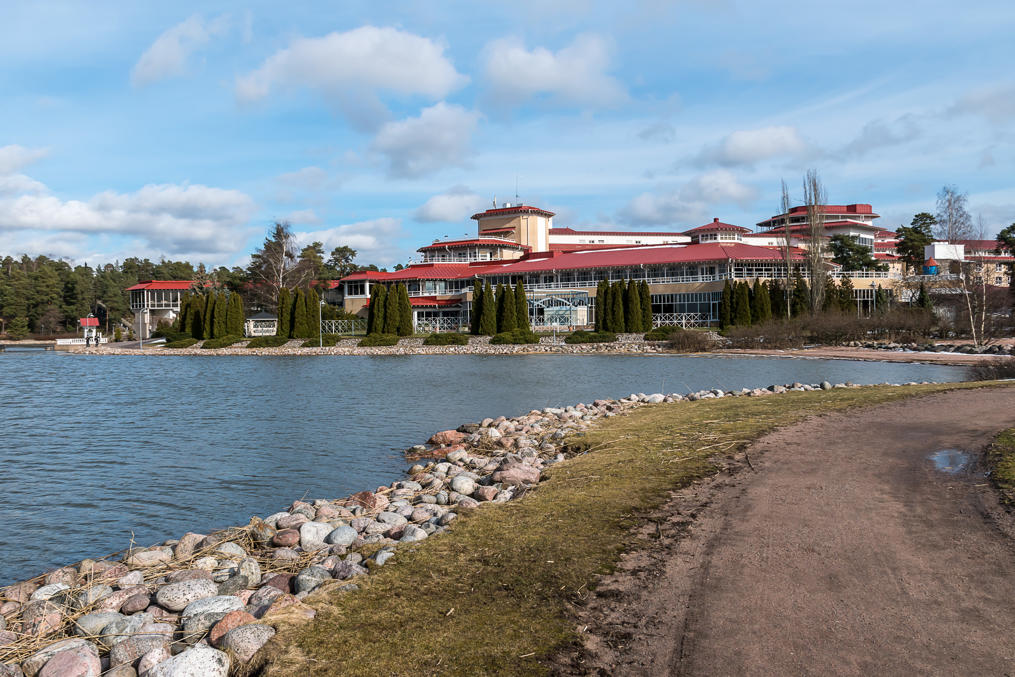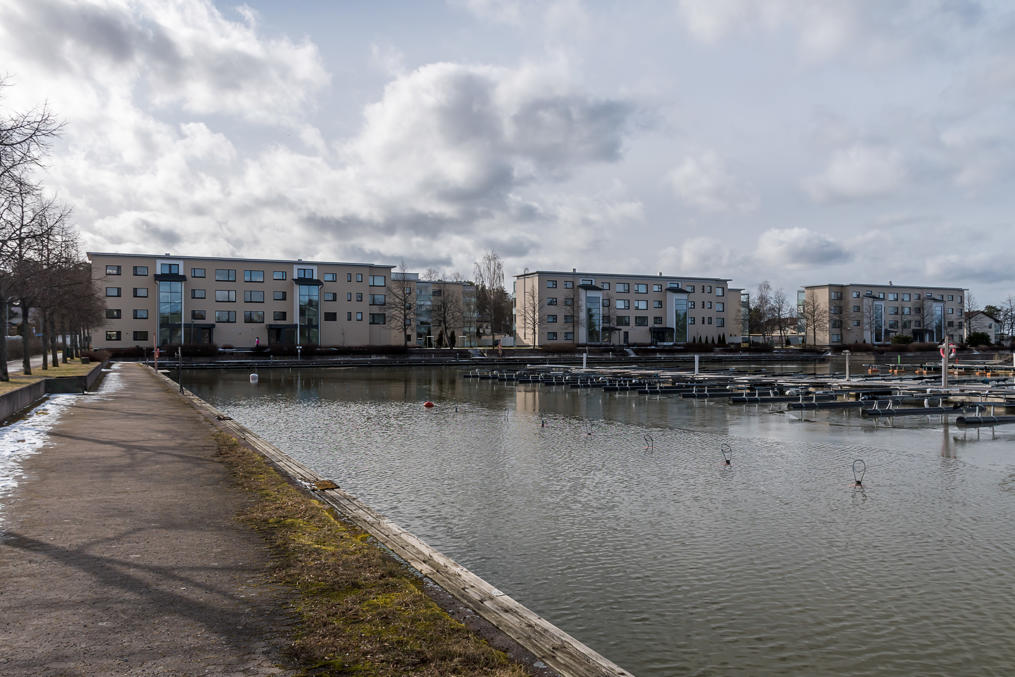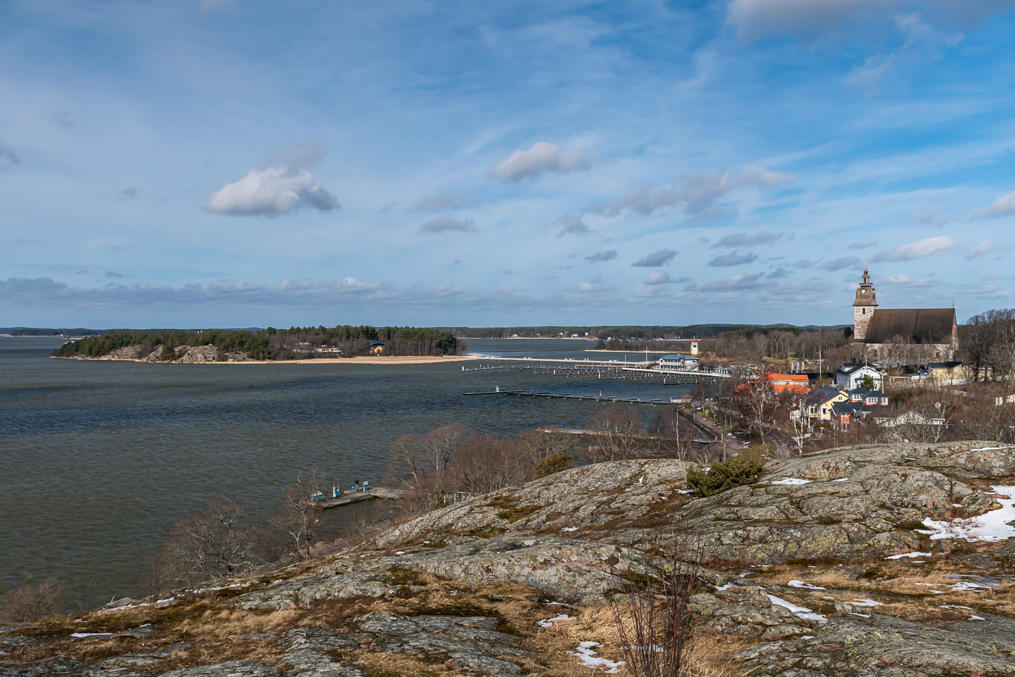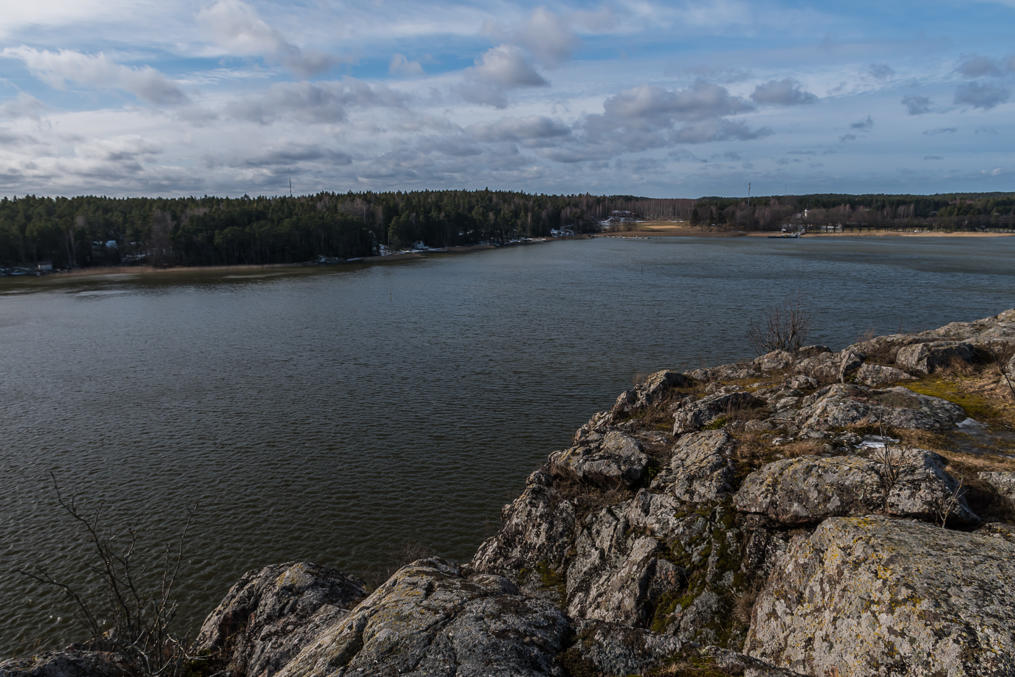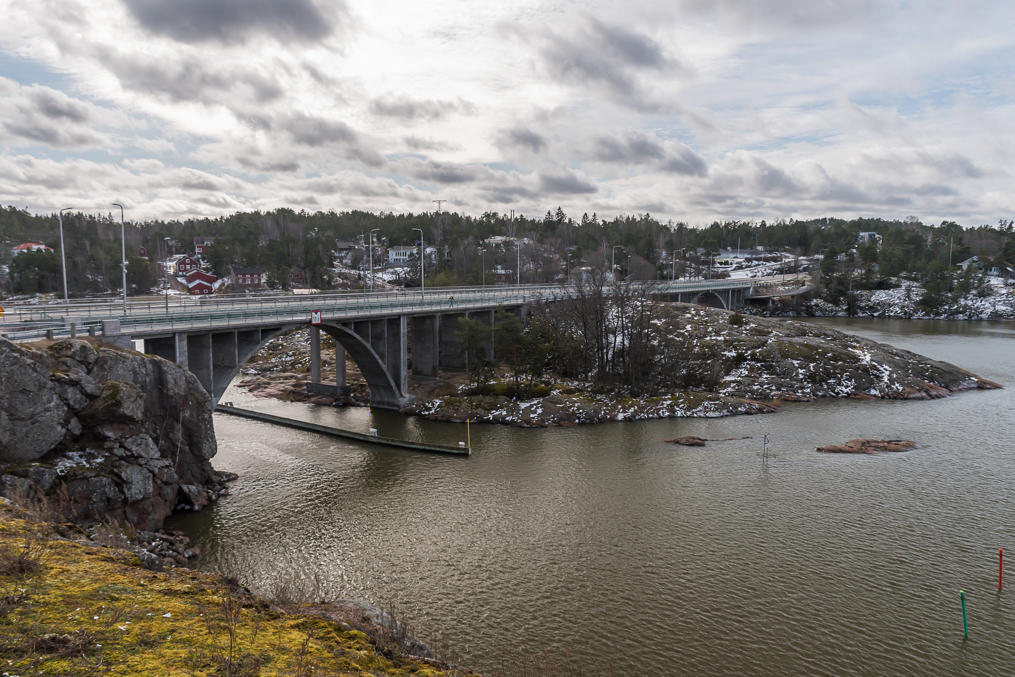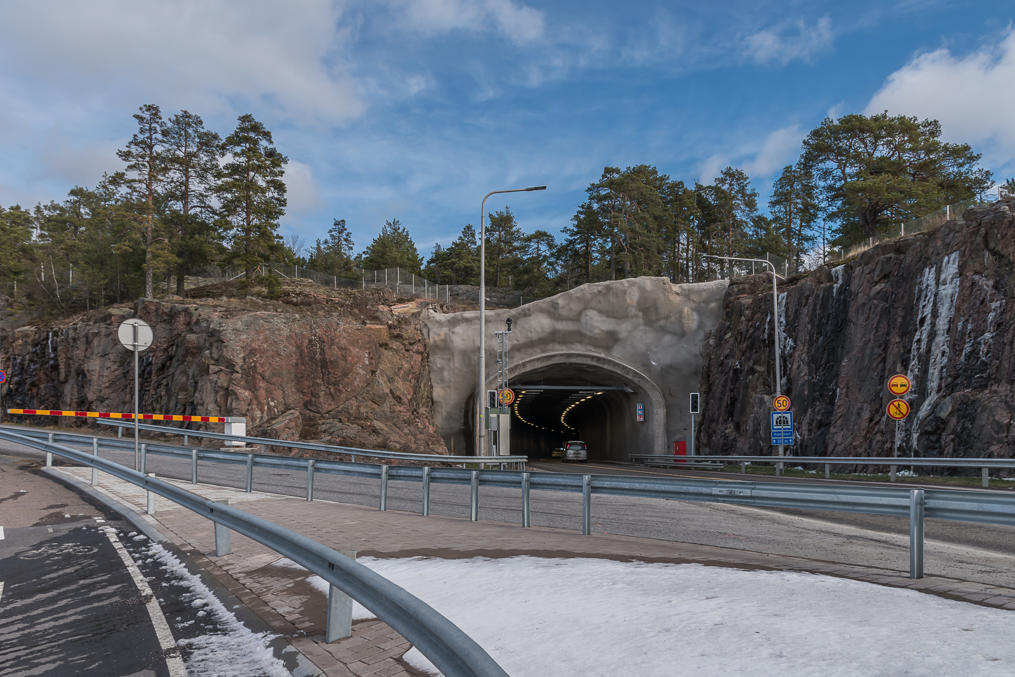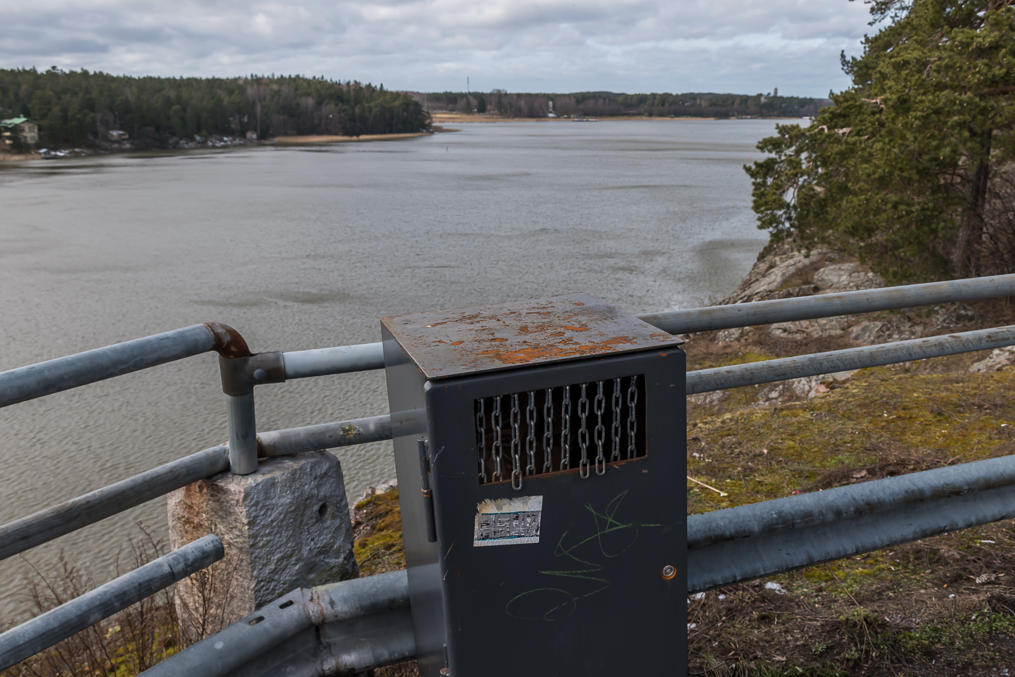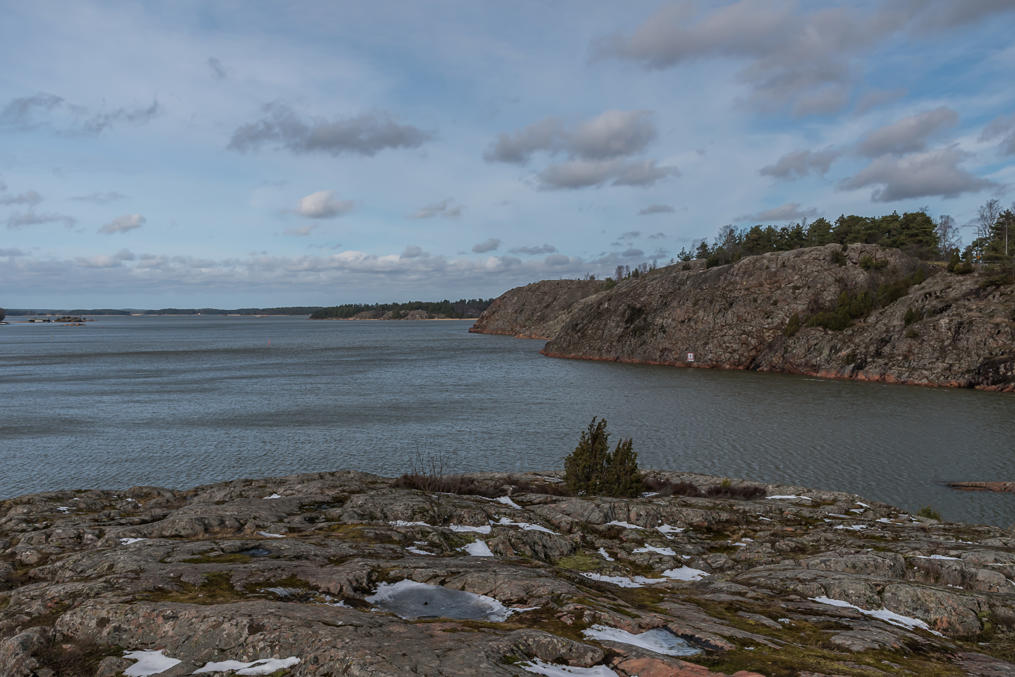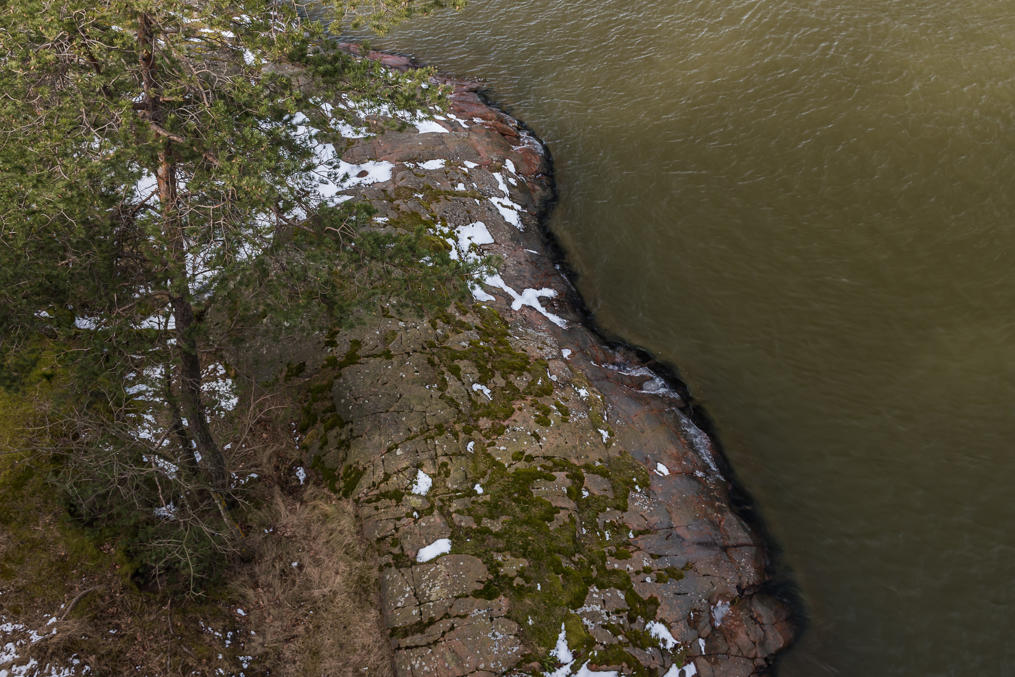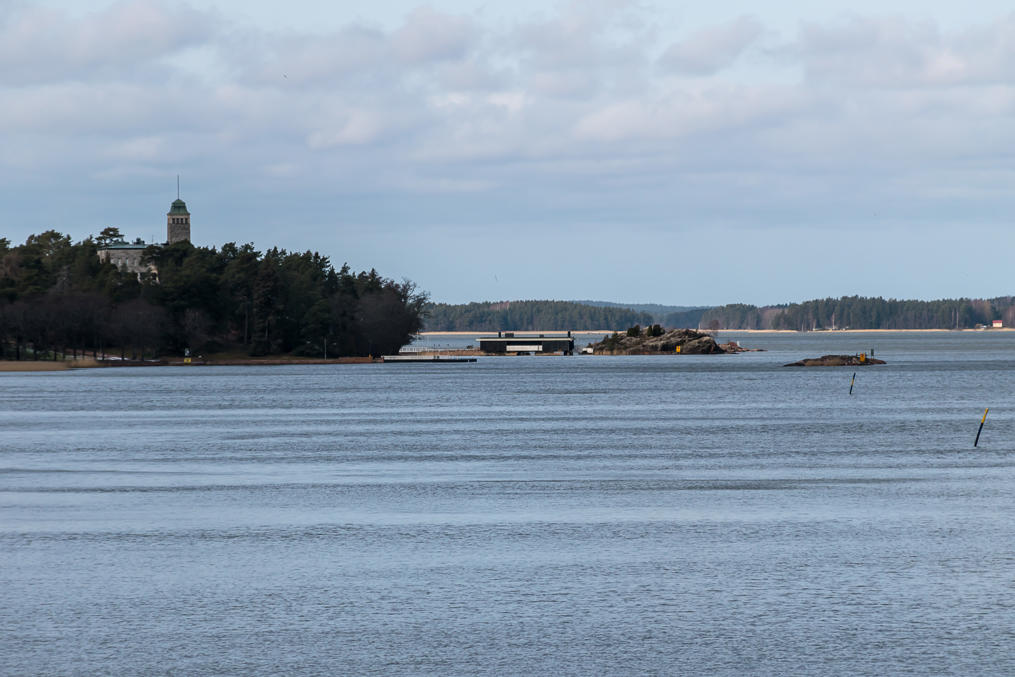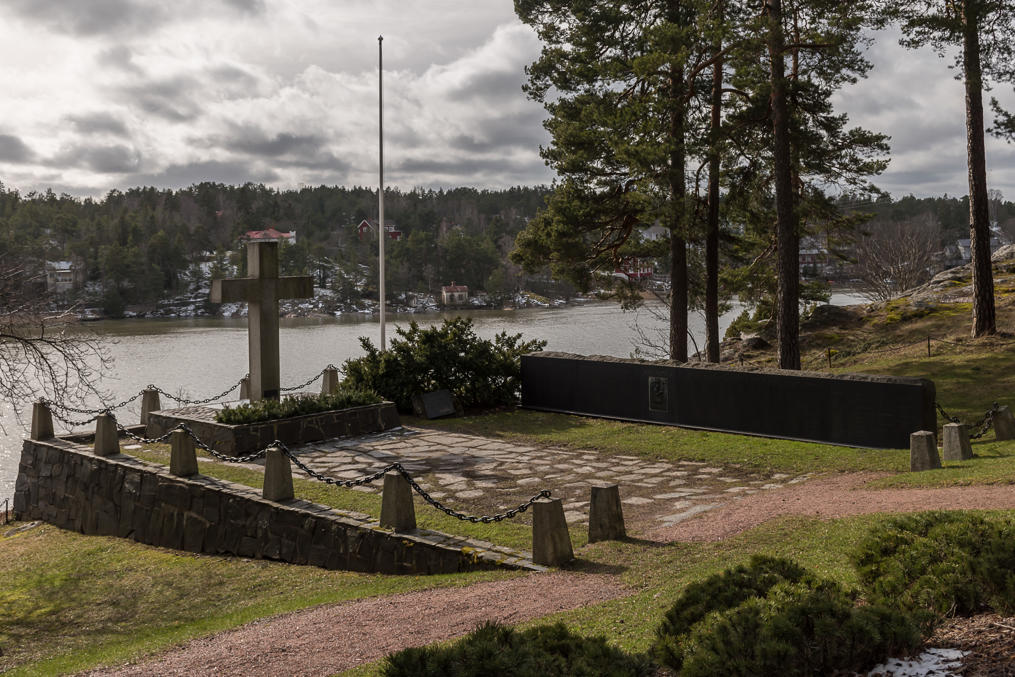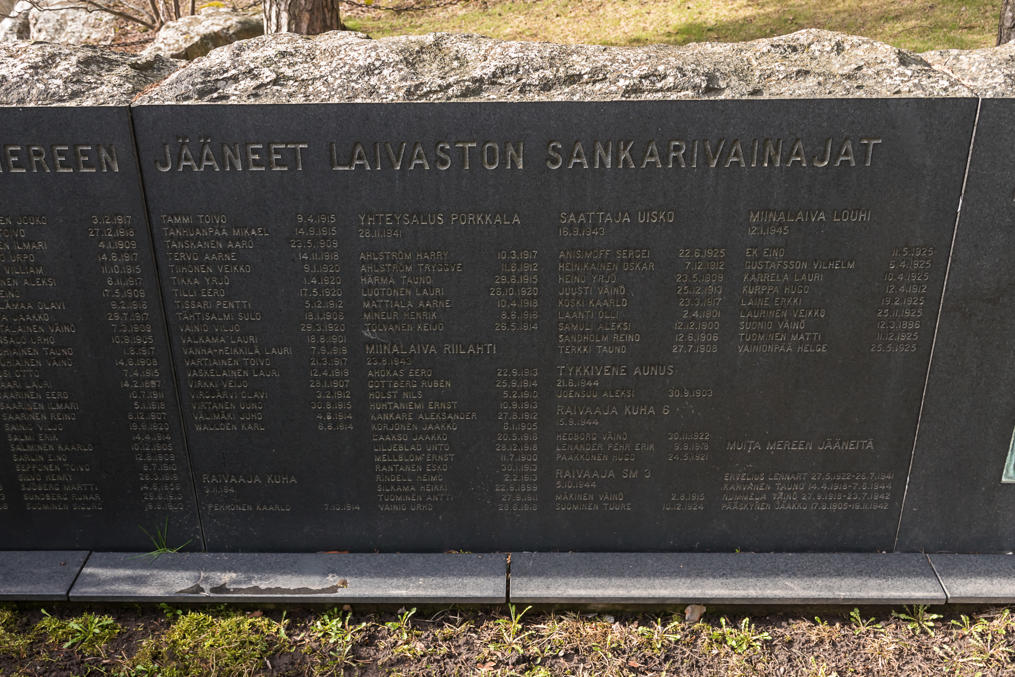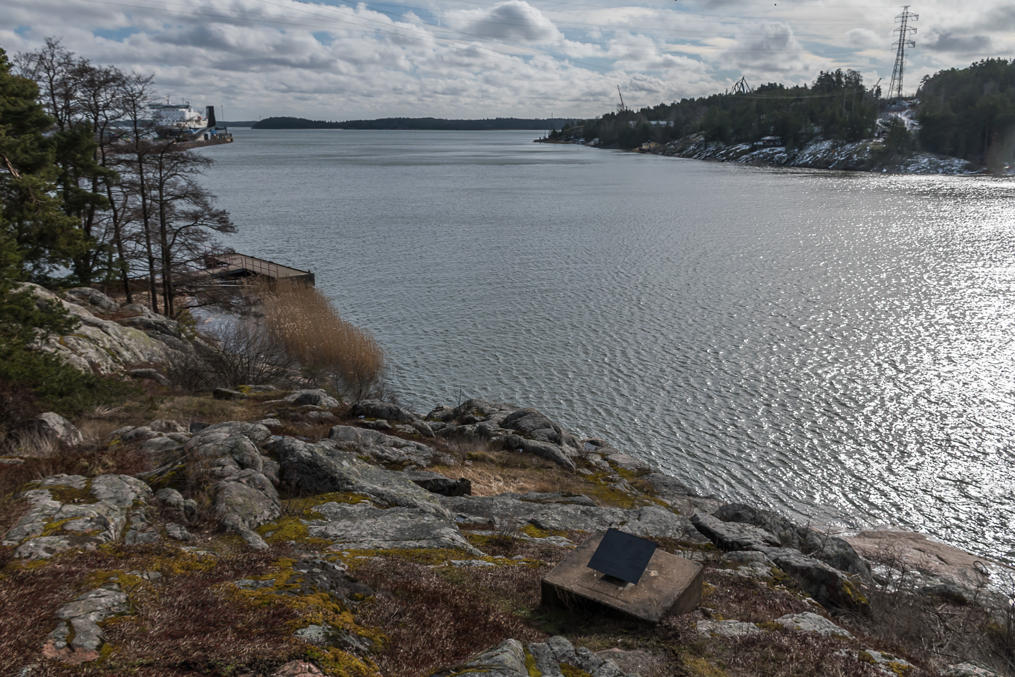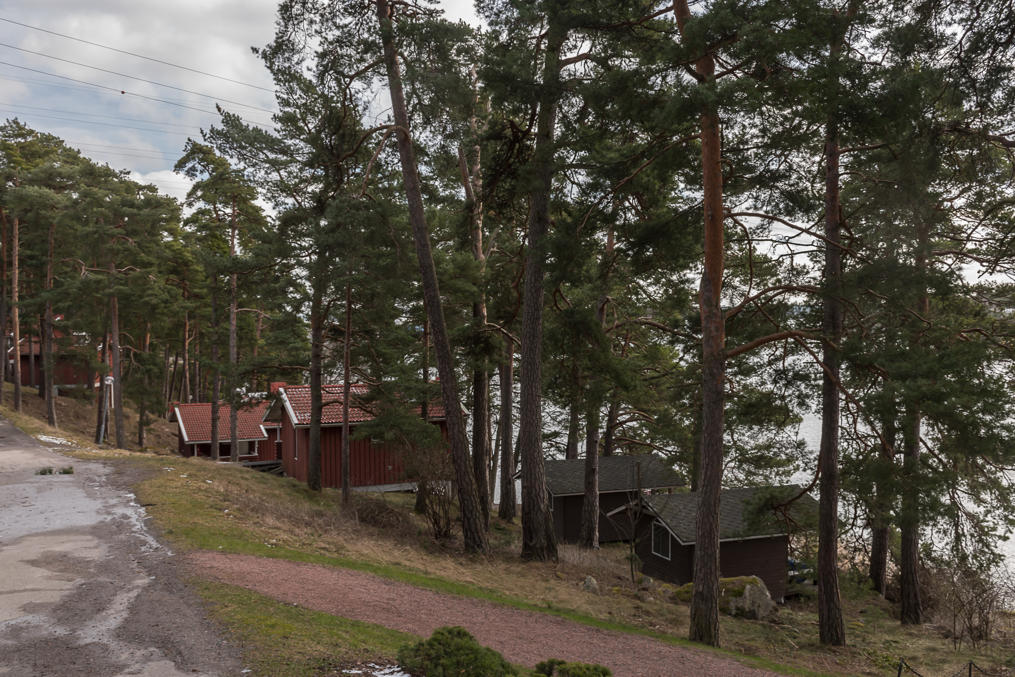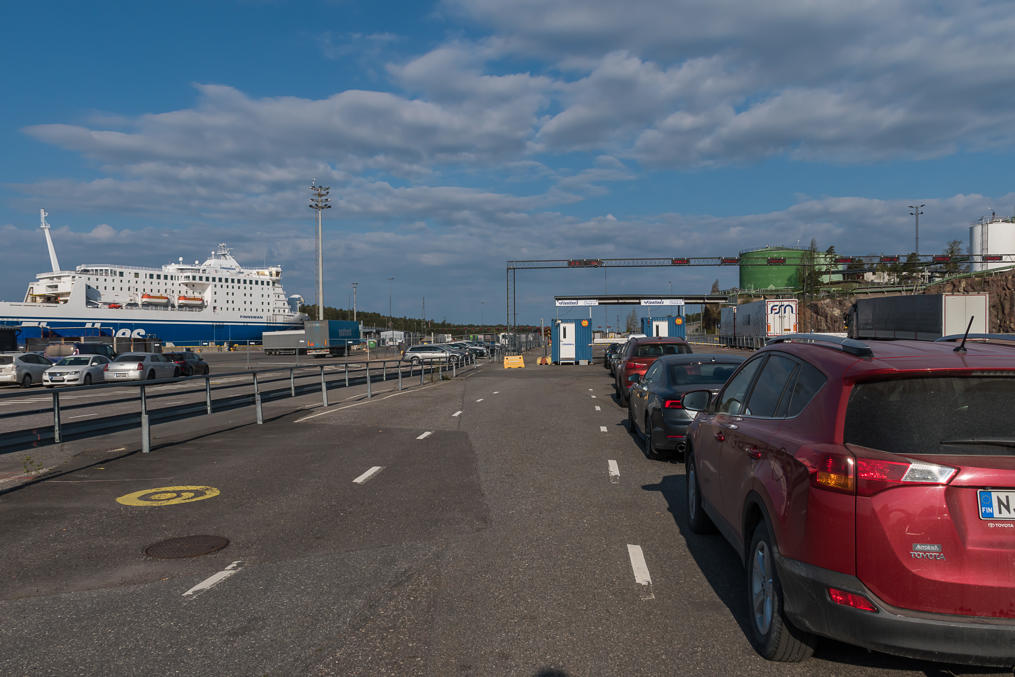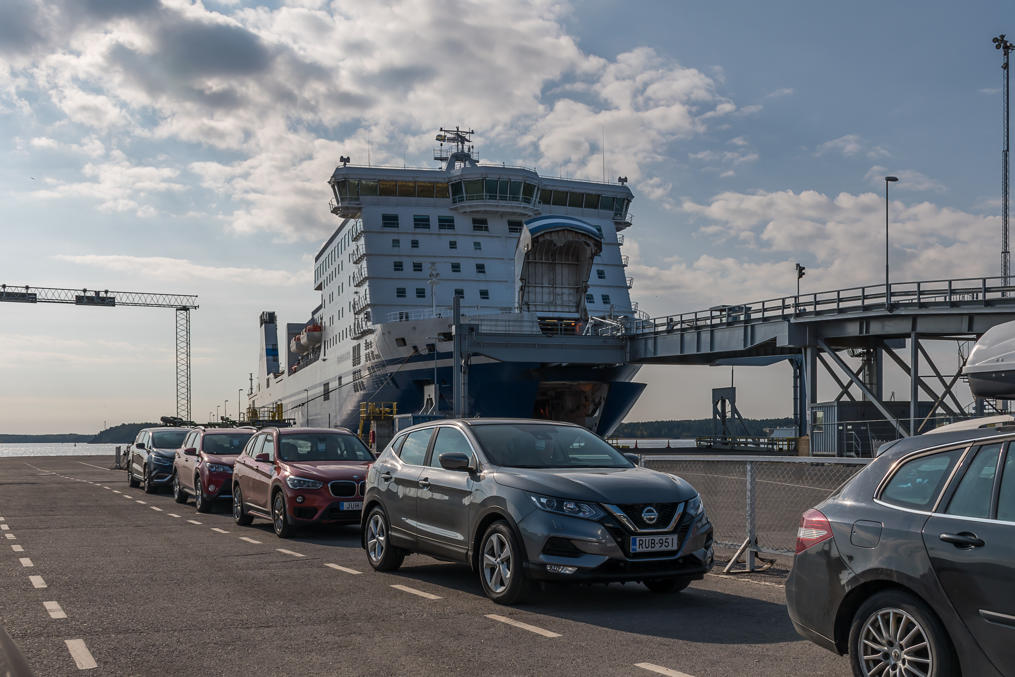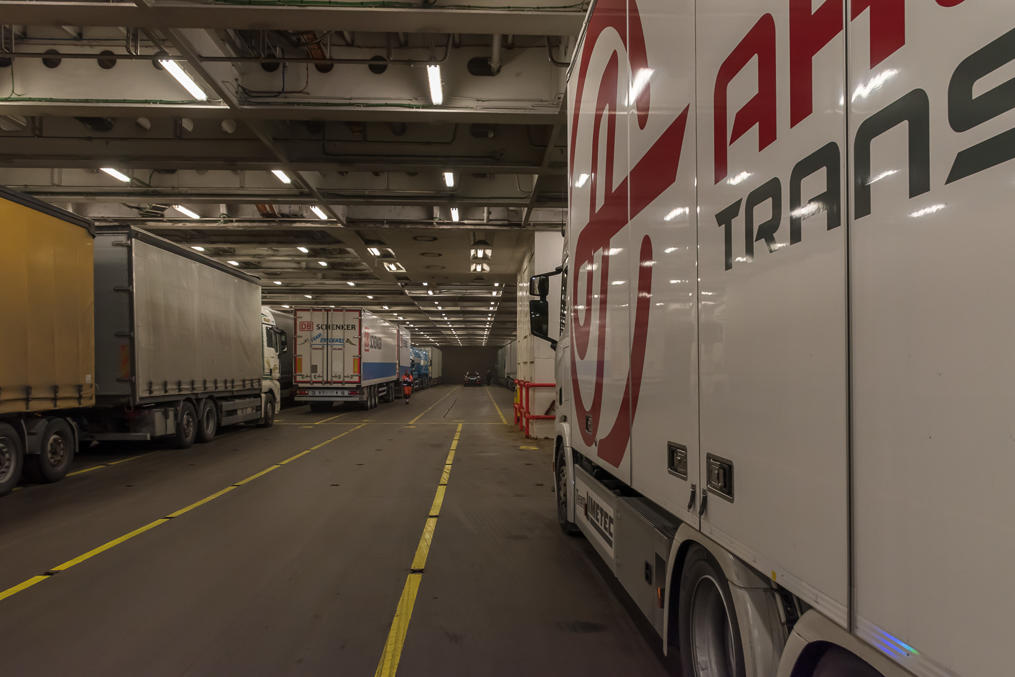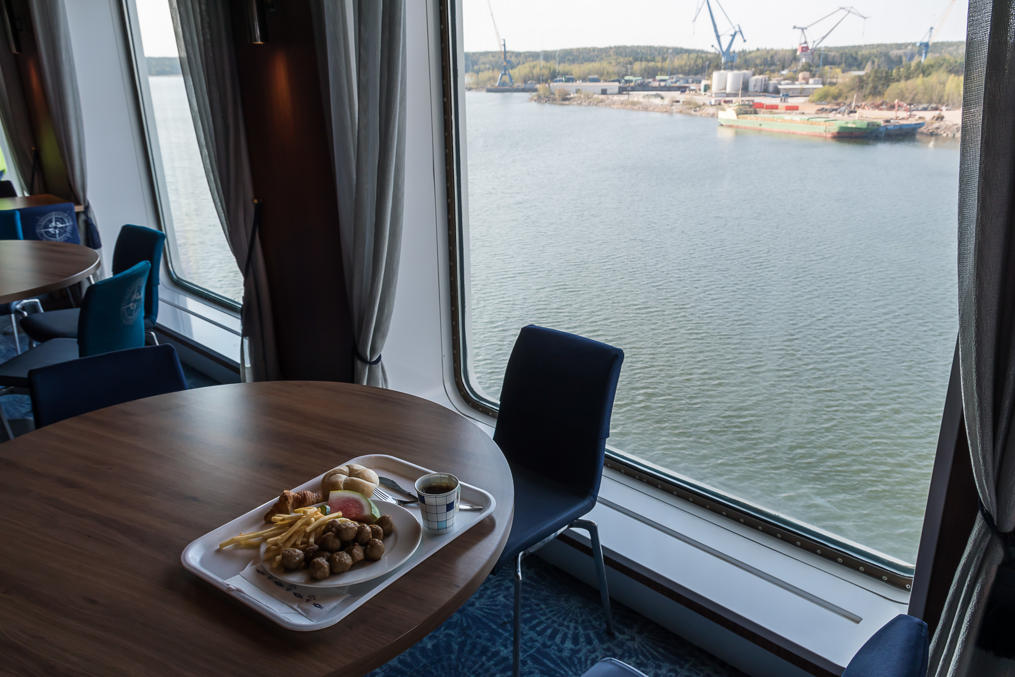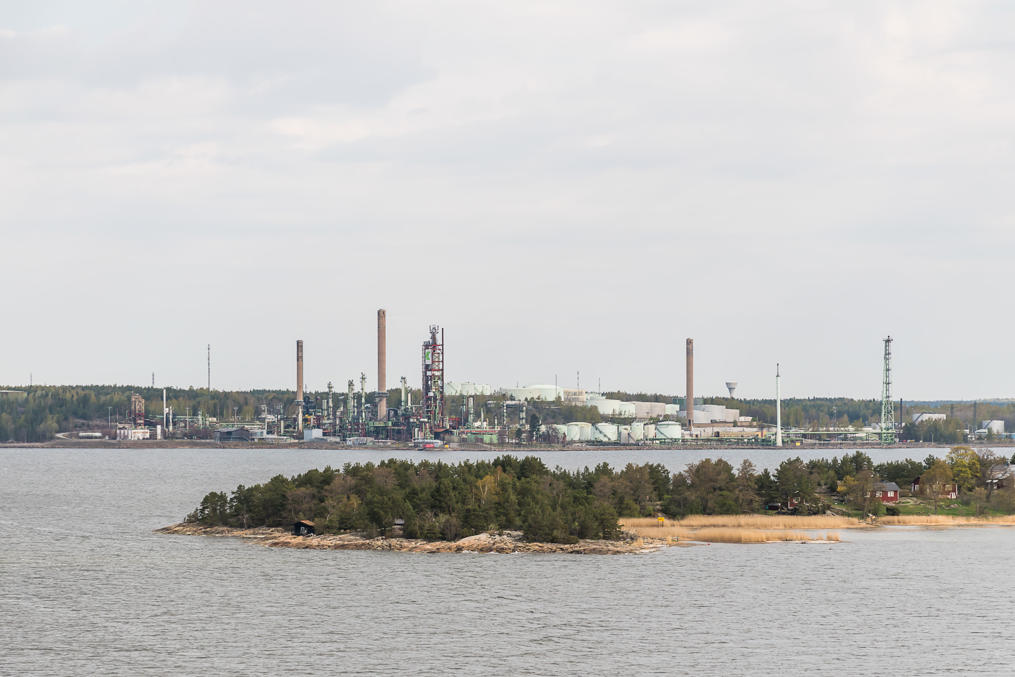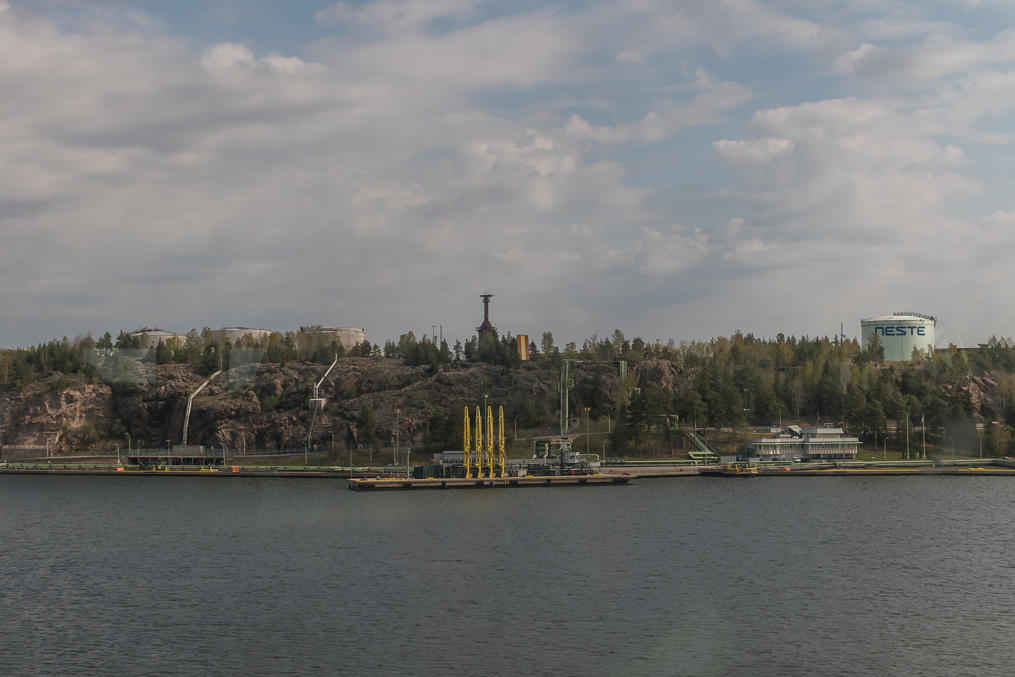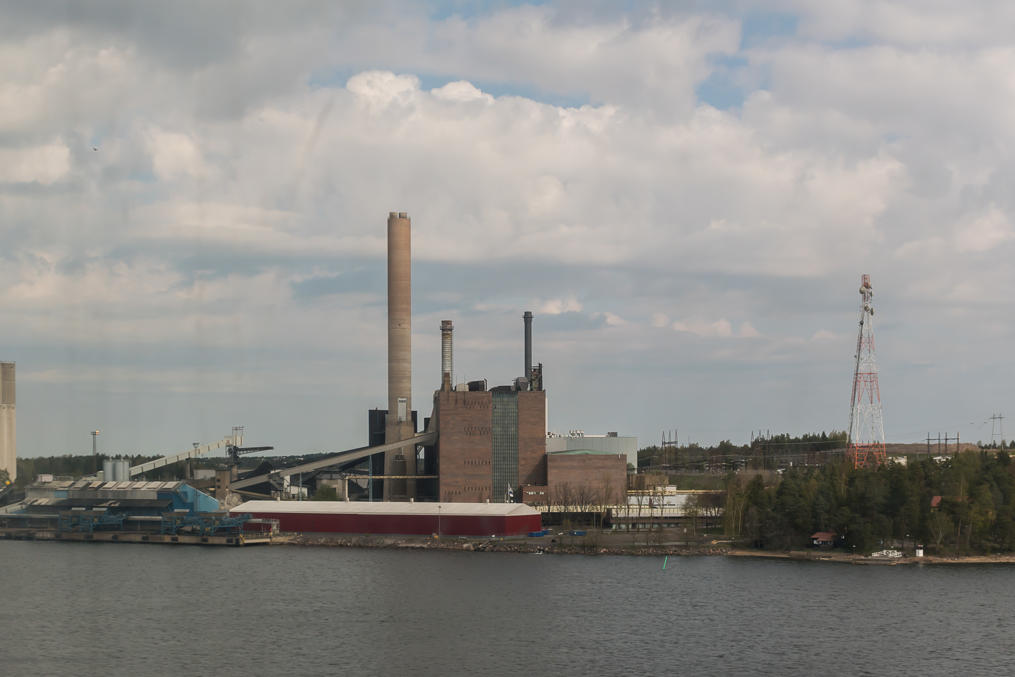After a look at the more touristy parts of Naantali, let's head to the modern city center, quite close to the old city. No surprises are really waiting for us there, but then we are also going to look at the sea-facing areas, which are rather interesting.
1. We spent the night in a place called Hotel Palo, which apparently is an old small wooden apartment building repurposed into a small hotel, on Luostarinkatu (Finn. Monastery Street). This part of the city between the old town and the commercial center has a mix of apartment buildings and 20th century wooden detached houses.
2. The city commercial center looks like this. In the background (with the coat of arms) is the city library.
3. The small tori (central market square).
4. The bus which will depart to Turku shortly (and the poorly repaired cobbled sidewalk).
5. Naantali city administration in a rather modern building.
6. War memorial. "The Finnish soldier fought in our wars of 1939-1945 for the home, religion and fatherland."
7. A small theater.
8. The center of the local nightlife, presumably.
9. A Hesburger, a local electricity company, and, on the right side, a bar for those who enjoy the more simple kind of nightlife.
10. A small park strip across the city center.
11. A small and oddly brightly colored fire station from the 1930s was recently converted into a commercial building. There is of course another fire station elsewhere in the city.
12. Some new apartment buildings, built higher here than in most of the city. Another house is being constructed nearby (note the yellow modules in the middle). The road next to a steep rock cut leads to the harbor, although the main road into the harbor is now elsewhere, bypassing the city entirely.
13. Less modern residential buildings at Myllynkiventie (Finn. Millstone Road).
14. These buildings are actually a bit curious; you don't often see four floor apartment buildings with wooden facades. The three identical apartment buildings, positioned in a way that someone entering the city by road will have a good look at them, were built in 2000. The first floor is concrete but the rest of the building is indeed wooden, including structural elements. Wooden apartment buildings have been somewhat popular in Finland especially in the latest years. As you can see from this list of such buildings, for many of them it is not really obviously by look that they are wooden.
15. Supermarkets and gas stations.
16. This is already the edge of the city central area, and behind an S-Market supermarket there are two massive empty parking lots. These are meant for the Moomin World visitors; parking space near the old town is limited, so in summer visitors arriving by car can leave their car here for 10€/day and then go to the Moomin World by a free shuttle bus. I'm not aware of a similar arrangement anywhere else in Finland (at least on a permanent basis; I saw such parkings and buses arranged for e. g. a housing fair). Similar major sights are mostly either outside city centers and have ample parking space, or within major cities where there are no special arrangements made.
17. Naantali railway station which can be found behing the supermarket and the Moomin World parking lot looks pretty sad. All that remains is a small rail yard with a few tracks that look nearly abandoned; the spur to the harbor branches off east of this rail yard, bypassing it, so these tracks are not used normally for any traffic. Passenger service to this station ended in 1972, and to the Naantali harbor in 1980. The 6 km long Raisio-Naantali railroad was originally built in 1923. Three different station buildings were in use throughout its history, each located in a different place. The first one, a beautiful wooden station building by Thure Hellström, was in particular disassembled and moved to Matkaselkä station in Ladoga Karelia — in 1938, just before the war, to the territory that was soon ceded to the Soviet Union. (As far as I was able to tell, that building hasn't survived to this day.) By now, however, all station buildings have been demolished.
Freight traffic to the Naantali harbor still continues, if not exceptionally busy. In 1967 train ferry operations between Naantali and Stockholm started, the first international train ferry connection in Finland. However it only lasted a few years. Train ferries were later operated from other harbors (Turku, Hanko, Uusikaupunki) but never again from Naantali. Train ferry service in Finland was abolished in 2012, and the required infrastructure in these harbors is mostly dismantled.
18. The end of the railroad. It used to be closer to the center, but the final ~300 m of the railroad were at some point dismantled to free up space for the residential construction.
19. Northeast of the city center is the massive Naantali spa hotel. This road goes into that direction, with some roundabout art, which seems almost obligatory for Finland.
20. And here is the spa hotel (Naantalin Kylpylä), located on the quiet northern coast of the city. An attentive person can spot a miniature blue Moomin house.
21. Spa hotel apartments on the sea coast.
22. An exercise ground nearby with a few simple machines.
23. There are some residential buildings right on the sea coast, too.
24. If we go along the coast to the west from the spa hotel, soon there'll be the church, the Moomin World bridge and the old town, all of which we saw in the previous post. And if we still walk on from the old town, then we'll run into Kuparivuori (Finn. Copper Mountain), a fairly low (20-25 m) rocky hill which however rises from the sea almost vertically. It is quite easy to get to the edge of Kuparivouri and enjoy the view.
25. The strait between Naantali mainland and Luonnonmaa island, Naantalinsalmi (meaning simply Naantali Strait). Luonnonmaa (Finn. Nature Land, yes a bit weird name) is an island approximately 10x3 km in size. Apart from the Kultaranta presidential residence, there is also a drydock and some detached house areas, but mostly it's just a rural sparsely settled island. Bridges and ferries connect Luonnonmaa to the rest of the archipelago area belonging now to Naantali. The biggest archipelago villages of Naantali are Rymättylä, Merimasku and Velkua, and all of them used to be independent municipalities but merged with Naantali in 2009. Rymättylä is known as the biggest early potato cultivation area in Finland; 1/3 of Finnish early potato fields are in Rymättylä (which in truth means only 230 ha (as of 2013); early potato is quite a minor thing to grow, overall Finnish potato fields area is about 26,500 ha). Velkua at the time of the merger with Naantali was the smallest Mainland Finland municipality by population, with only 264 people. (In fact it was, of course, an island municipality and only ever was connected to the mainland by ferry, but the term Mainland Finland means simply "Finland without Åland Islands", and does in fact includes islands and archipelagoes that are not in Åland.) We didn't visit Luonnonmaa or any others of these archipelago areas this time, however.
26. And the strait is closed by a bridge, or actually two bridges. The original one is named the Ukko-Pekka Bridge (Ukon-Pekan silta). It was built in 1934, and Ukko-Pekka — "Old Man Pekka" — was the nickname of the Finnish president at the time (1931-1937), Pehr Evind Svinhufvud (apparently he was okay with the nickname). The man in fact had a quite colorful career even before his presidential term; he was a major proponent of Finnish autonomy even before Finland declared independence from Russia, and for his open disagreement with Russian authorities he was exiled to Tomsk in Siberia in 1914-1917. He was able to return to Finland after the Russian February Revolution, to extremely welcoming reception, and resumed political activity. He became the chairman of the Finnish Senate on 27.11.1917 and thus and became the person who officially proclaimed Finnish independence, signed the declaration of independence (with the rest of the Senate), and travelled to revolutionary Russia, to Petrograd, to meet with Lenin and ensure he personally recognizes Finnish independence. Afterwards Svinhufvud was the first State Regent of Finland during the bloody Civil War era; he however was also the one who also began the amnesty of the Reds after the war (on 30.10.1918 all Red prisoners with prison terms less than four years were pardoned). On 12.12.1918 he resigned from regent duties and did not participate in the first presidential elections in 1919, but in 1931 got elected as the third President of the Republic, from the National Coalition party (Kokoomus), and generally enjoyed great popularity during his term. Possibly his most significant deed was the explicit condemnation of the fascist so-called Mäntsälä Rebellion of 1932; its participants were assuming Svinhufvud, a conservative and somewhat nationalist even leader, would support them, but he refused, and the coup lost hopes for popular support and was easily defeated. Had Svinhufvud acted differently, Finland might well have been a Nazi dictatorship by the time of the war.
The bridge, thus, was named after the president (in fact the president participated in the opening ceremony himself; not a very modest man Old Man Pekka probably was, although the name was not his own idea). It was a big and expensive project at the time, especially considering that Luonnonmaa is not especially huge and had farly low population, and the bridge was built mostly explicitly for the purpose of connecting Kultaranta to the mainland. The exact place chosen was Raumakari, a small rocky islet in the middle of Naantalinsalmi. The bridge thus goes across Raumankari and has two large arch spans on both sides of it.
By the 1970s Ukko-Pekka bridge was already inadequate for the traffic, especially when road networks, including bridge and ferry connections, in the archipelago improved. The old bridge was only 5 m wide, narrow enough that two trucks count not pass each other. A new bridge, named simply Naantalinsalmi bridge, was built next to the old one in 1986. The new bridge was a much simpler beam design, and since it exactly follows the shape of the old bridge, the overall view has really not changed much, and the beautiful arches of the Ukko-Pekka bridge are far more prominent than the Naantalinsalmi bridge supports. Ukko-Pekka bridge was repurposed for pedestrian and bike traffic. The road over the bridge to Luonnonmaa and farther on to Rymättylä is currently numbered as Regional Road 189.
Ukko-Pekka is also the name of an old steamship Ukko-Pekka that operates on Turku-Naantali route in summer. With two departures every day (except Sunday and Monday) it should be a pretty interesting way to get to Naantali. In other times of year that steamship can be observed in Turku, docked in the Aura river.
27. A few years after the Naantalinsalmi bridge construction, in 1989, the Kuparivuori Tunnel was also taken into use. The tunnel allows cars to completely bypass built-up areas of Naantali when going to Luonnonmaa; the old road over Kuparivuori hill, visible to the left, also goes via city residential streets. The tunnel, 320 m long, was the very first road tunnel in Mainland Finland (oddly enough Åland got its first and only tunnel earlier, in 1980, although their tunnel is quite tiny at 51 m). Not being a mountainous country, Finland only really needs road tunnels for some motorways and in some built-up areas in cities.
28. A trash bin near the bridge is protected by chains for some reason, against birds, possibly. Never seen such a thing before.
29. View from over Raumakari islet. The combination of steep sheer rock cliffs over the sea and a tunnel nearby gives this place some unexpected Norwegian vibes; both these things are extremely common in Norway and very uncommon in Finland.
30. Raumakari below the bridge.
31. Kultaranta presidential residence visible in the distance from the Ukko-Pekka bridge. It's difficult to make out details, but you most definitely can see the presidential sauna on a pier. Because what would be a Finnish presidential residence without a proper sauna? The pier nearby is presumably where the presidential boat, Kultaranta VIII (yes, there had been seven others before), docks sometimes. Kultaranta VIII is built in 2008 at Uusikaupunki shipyard, and is maintained (and presumably kept off season) at the nearby naval base at Pansio.
Few if any pictures from Kultaranta itself are available, at least of the interiors. Kultaranta is supposed to be a proper home, which also means the domestic privacy of its residents must be respected (there is a good word for that in Finnish, kotirauha — "home peace"). It is, however, allowed to visit the gardens, which are rather vast (54 ha), if only in summer season and only for a few hours on Fridays.
The mansion was originally built in 1916 by Alfred Kordelin, a famous entrepreneur and philanthropist and one of the richest Finns of the era. The mansion was designed by Lars Sonck. Kordelin however managed to spend only one summer at Kultaranta. On 7.11.1917 he was killed by Russian seamen in the skirmish that is known as Mommila bloodbath (Mommilan veriteot). Mommila was Kordelin's another, older mansion, at Lammi in Häme province. A group of several dozen armed Russian seamen, led by a local Finn, some Johan Skott, a spirit smuggler, arrived to the mansion and took hostage Kordelin and other people present, including Kordelin's guests (Kordelin held his birthday party on 6.11). Among these guests was the future war-era president of Finland, Risto Ryti, who at the time worked as Kordelin's lawyer. The Russians were among those who had been previously stationed in Finland, and called to Petrograd to support the Bolshevik revolution. They apparently mistakenly believed Mommila mansion to be some sort of a White Guard base, but were not at all opposed to the idea of pillaging and taking revenge against rich people in general. Skott meanwhile had a specific grudge against Kordelin; he had been a tenant farmer at Kordelin's lands, but had been evicted by him. Kordelin managed to contact the local White Guards by phone and they arrived to the nearby railway station to help, while Russians were also taking the hostages to the station after stealing from the mansion what they could, and destroying what they couldn't take. In the ensuing shootout Kordelin and his estate manager Paul Pettersson were executed by Russians. A few White Guards were killed, and Skott was mortally wounded and died a few days later in a hospital. Russian losses were not noted well; the survivors escaped into the woods. The entire incident was rather unique; I'm not aware of any other clashes between revolutionary-minded Russian troops and the general Finnish population at the time.
Kordelin never married and had no children, thus all his riches went to a foundation established in his name to promote Finnish culture (that still exists today). Kultaranta in turn went to the Turku Finnish University Society (Turun Suomalainen Yliopistoseura), that also exists today, and Finnish state acquired Kultaranta from them in 1922, when it was decided to acquire a summer presidential residence.
32. Getting back to Kuparivuori and descending from it on the other side, you can see a cross rising over the sea. This is the monument to the Finnish navy losses in the wars of 1939-1945. This was the place where funeral services were held a few times in the war and after it for those who never returned from the sea.
According to the nearby plaque, 79 men of the Finnish Navy died in the Winter War of 1939-1940, 698 died in the Continuation War of 1941-1944, and 28 more died in the mine sweeping operations after war in 1945-1950. The monument has 403 names on it.
These are, of course, relatively minor numbers considering the overall scope of wars. Finnish navy has always been quite small (and is still quite small today), and while some naval clashes between Finnish and Soviet forces occurred in the wars, this never really was a significant battleground. Finnish and German navies started laying extensive minefields across the Gulf of Finland immediately with the outbreak of the war in 1941, which was an extremely effective measure; Soviet Baltic Fleet, a significant power in theory, was locked in the vicinity of Leningrad in Eastern Gulf of Finland for most of the war. Direct clashes between it and the Finnish Navy were therefore not really necessary. After Finland's exit from the war in 1944 it was forced to sweep all the minefields itself by the conditions of the Moscow Armistice.
33. Some sunk Finnish ships and names of their deceased crew members.
34. There is a separate plaque for the coastal defense ship Ilmarinen, the greatest single naval loss of Finland. Ilmarinen, named after the legendary smith from the Kalevala epic, was the flagship of the Finnish Navy, built in 1927 in Turku, a 93 m long ship, 3900 t displacement, crewed by 403 people on the day of its sinking, 13.9.1941. Ilmarinen with other Finnish ships participated in Operation Nordwind, a joint German-Finnish operation meant to distract Soviet attention. Nordwind force was to bombard strategically important Estonian islands of Hiiumaa and Saaremaa (occupied by the Soviets at the time) from the west and land some troops, all the while the real German offensive (Operation Beowulf) would actually strike from the east. However shortly after the Nordwind force departed from Turku and left the Archipelago Sea, Ilmarinen struck a mine in some 24 miles southwerst of Utö island. The ship received devastating damage and sunk in mere minutes. 271 people went down with the ship; others were rescued by the rest of the Nordwind group, which was forced to turn back. The entire operation was a complete failure (Operation Beowulf however succeeded anyway, and Germans were successful in capturing the islands and killing or taking prisoner most of the Soviet garrison there). To this day it remains unclear, whose exactly mine actually sunk the Ilmarinen; it could be a Soviet one or a German or Finnish one that accidentally detached from its place and drifted to the area.
Ilmarinen's sister ship, Väinämöinen, survived the war and was ceded to the USSR as part war reparations where it operated under the name Vyborg and was scrapped in 1966. Ever since Finnish Navy has never had any ships of similar size. Currently its biggest ships are the two Hämeenmaa-class minelayers (Hämeenmaa and Uusimaa) at 78 m long and 1450 t displacement. However Pohjanmaa-class corvettes, four of which are to be built in the 2020s, would actually be bigger than Ilmarinen and Väinämöinen.
35. Another memorial plaque can be spotted below the cross. It tells about the history of Naantali itself as a naval base in war years.
36. The cross is located near a camping area, with nice friendly-looking cottages clinging to the sea coast.
37. The area beyond the camping is off limits. This is where the oil refinery and the harbor are. It is not possible to see the name of docked ship, but it's most certainly one of the Finnlines ro-pax ones.
Grain silos are visible in the left of the picture. These are the biggest grain silos of Finland, 85 m high and able to store 230,000 tons of grain. Silos were gradually built from the 1950s to the 1980s. They are owned by Suomen Viljava state corporation (from viljavarasto, which means "grain silo"), along with other grain silos in 19 various locations all over the country. Their total storage capacity is 1.4 million tons. The grain of course is not stored forever and eventually gets used, but Suomen Viljava also makes sure there is enough grain for a possible countrywide state of emergency. By law Finland must have at all times at least 6 months grain reserves; it is said to be currently enough for 12 months in practice. Self-sufficiency is a very topical issue everywhere in the world right now, during the coronavirus pandemic, and Finland is actually quite well prepared for emergencies; it also has secret storage facilities with fuel, medicines and all kinds of supplies, and a few days ago these facilities were used for the first time in the ongoing corona crisis.
38. And now we'll move almost a year into the past, to the beginning of May 2019. I was boarding the Finnswan ro-pax ship at Naantali then. This is what the queue and registration booths look like, quite modest really.
39. Naantali harbor administration.
40. Finnswan is built in 2007 in Italy, at Fincantieri shipyards (despite the name, these shipyards have nothing to do with Finland and are one of the most important shipyards of the world building passenger vessels). Until 2018 it was named Nordlink and operated on Helsinki-Travemünde (Germany) route. Helsinki-Travemünde is the only Finnish "long-distance" ferry line available for passenger cars, and might be better familiar to tourists than the Naantali-Långnes-Kapellskär one where the Finnswan currently operates. A trip to Travemünde takes 27 hours and is considerably expensive, although driving through Baltic countries and Poland or through Finland and Sweden (which would also involve at least one ferry) is not especially fast and cheap either. Finnswan's sister ships Finnmaid, Finnlady and Finnstar all operate on Helsinki-Travemünde route, departing not from cruiseferry terminals near the city center, but from Vuosaari cargo harbor on the very eastern outskirts of Helsinki. Another Finnswan sister ship, Europalink, operates on Malmö (Sweden)-Travemünde route. Naantali-Långnes-Kapellskär route is also served by Finnfellow, Finnclipper and Finneagle; all of them are ships of an older class and were originally ordered by Swedish Stena Line.
Naantali-Långnes-Kapellskär trip takes about 10.5 hours; there are two daily departures both from Naantali and Kapellskär, in late morning and the overnight one in the late evening. I was only taking the Naantali-Långnes leg, which was taking 5 hours and cost me 49€ (would have been 29€ without a cabin). Finnswan departed at 10:15. I still lived in Vaasa at the time, which meant I had to drive about 330 km from Vaasa to Naantali, and had to get up at about 4:30.
41. Finnswan car deck full of trucks.
42. The upper car deck is partially open.
43. Apparently Finnlines includes free meal at an all-you-can-eat buffet in all tickets on the Naantali-Långnes-Kapellskär route, which is very nice of them! The meal is not a fancy one, more like the kind you can get at a gas station restaurant, but this is exactly what I like. For comparison, on Viking Line ferries an evening meal in such a buffet costs something like 30€ alone. Of course they offer a lot more kinds of food, and also unlimited alcohol (beer and wine).
Most other people at this restaurant were very obviously truck drivers, and surprisingly many of them were actually speaking Russian with each other.
44. A few industrial areas are best viewed from ship, most importantly the Neste oil refinery. The refinery started as a fuel storage facility; the idea for it first appeared in the war years, but the facility construction started only in 1944 already, and in 1948 the Neste state company was established. Neste means "liquid" in Finnish. At the time most oil was coming to Finland from the west. However the Soviet Union needed Finnish industry products, and while in first years after the war it was getting them as war reparations, eventually (by the 1950s) all reparations were paid out, and the Soviet Union had to begin offering something back. And what it could offer was crude oil. Western oil companies opposed the construction of the Naantali refinery and threatened to close down their gas station chains in Finland over that. Still in 1954 the parliament made the decision to proceed with the construction, and the threats of oil giants turned out to be empty; they ended up quite happily buying gas made from Soviet oil from Neste, and reselling it at own gas stations. Neste has also its own gas station chain, which is the second most popular in the country after the S-Group owned ABC (S-Group also owns for example S-Market and Prisma stores). Neste is currently the biggest Finnish company by turnover and amount of corporate tax paid. In truth it is now a public company and the Finnish state is only its biggest shareholder, owning about 40% of it.
Not all gas (and diesel) sold in Finland is coming from Neste. In particular a significant share of fuel sold at non-Neste gas stations comes from Swedish Gothenburg (by Preem) and some also from Danish Kalundborg (by Statoil). They run on oil from North Sea fields.
Naantali refinery currently produces about 3 million tons of fuel yearly. 60% goes to domestic markets and 40% abroad. 120 gas tank trucks fill up there daily, and 350 tanker ships unload at Naantali yearly. Virtually all (over 90%) oil is coming by ship from the Russian port of Primorsk, northwest of St. Petersburg.
Update May 2021: Neste decided in November 2020 to shut down Naantali refinery permanently. All operations will be concentrated at their other, bigger and newer, refinery in Finland, at Kilpilahti near Porvoo. The decision was a major shock to Naantali and its residents.
45. Storage tanks take up a vast area near the refinery. Only a few of them are visible from the sea.
46. Naantali power plant. In truth there are two power plants. The one visible is the coal-fired one, in operation since 1960. The coal-fired power plant is nearing the end of its life cycle (which nicely coincides with Finland's plans to give up coal by 2030), and only one of its three power units is in regular use. A new multi-fuel power plant was constructed nearby in 2017. It mostly runs on woodchips originated from domestic forest industry, but also on coal and associated gas, which is a byproduct of the oil refinery operation. The new power plant currently provides 142 MW of electrical and 244 MW of central heating power, which for now is less than the old coal-fired one could (256 MW and 350 MW correspondingly).)
Other nearby industry that I don't have any pictures of is an Exxon motor oil plant and, on the Luonnonmaa side of the strait, Turku Repair Yard (Turun korjaustelakka), which despite the name is neither in Turku nor is currently associated with main Turku shipyards. The repaid yard was established in 1989 and operates the largest drydock of North Europe (if you believe Wikipedia), able to accept ships up to 265 m long, 70 m wide and 7.9 m deep (Aframax dimensions). The drydock at Suomenlinna in Helsinki (the only Finnish drydock east of Hanko) is also owned by the same company. The repair yard is currently owned by Estonian BLRT Group.
47. Finnswan leaves Airisto strait and heads towards Åland Islands through the Archipelago Sea, and our story about Naantali ends here.
